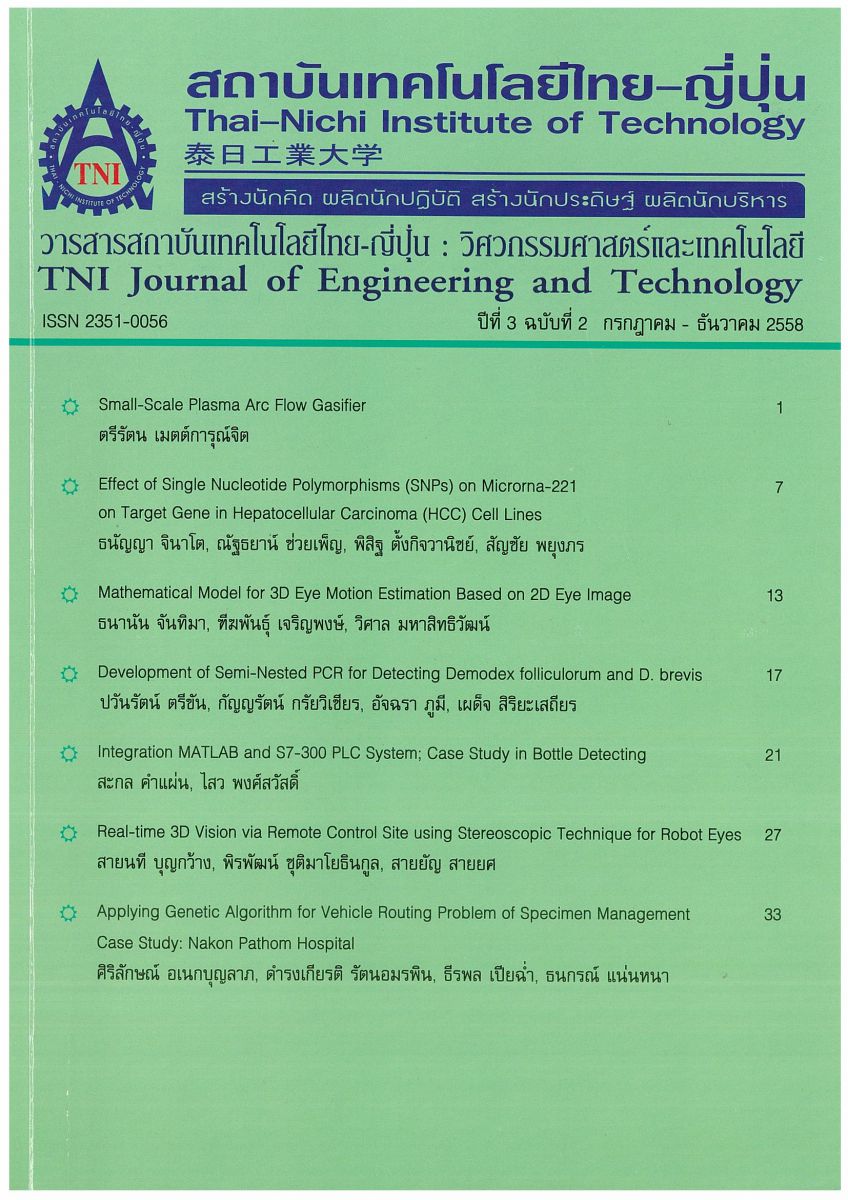Development of Semi-Nested PCR for Detecting Demodex folliculorum และ D. brevis
Main Article Content
Abstract
Demodex are tiny ectoparasitic mites, live in sebaceous glands. There are only two species, D. folliculorum and D.brevis found in human. Identification between both species could be done based on the morphological appearance of the adult stage. However for other stages especially egg and nymph, they are indistinguishable, therefore it causes difficulty for epidemiology study. This present study proposed the using of molecular technique for detecting and differentiation between these two human Demodex species. Primers were designed based on 18SrRNA gene of human Demodex mites. The 18SrRNA gene is usually used for Acari arthropods evolution studies because of its high variability. Total DNA was extracted from skin samples and was used to amplify the himan Demodex mite by using Semi-Nested PCR. The PCR was able to amplify the 18SrRNA gene from both human Demodex mite species with approximately 382 bp and 317 bp for D. folliculorum and D.brevis, respectively. The data obtained from the study provides fundamental data for accurate identification of the human Demodex and therefore for futher epidemiological study in the future. In addition, this report is the first study using molecular techniques to investigate human Demodex in Thailand.
Article Details
Article Accepting Policy
The editorial board of Thai-Nichi Institute of Technology is pleased to receive articles from lecturers and experts in the fields of engineering and technology written in Thai or English. The academic work submitted for publication must not be published in any other publication before and must not be under consideration of other journal submissions. Therefore, those interested in participating in the dissemination of work and knowledge can submit their article to the editorial board for further submission to the screening committee to consider publishing in the journal. The articles that can be published include solely research articles. Interested persons can prepare their articles by reviewing recommendations for article authors.
Copyright infringement is solely the responsibility of the author(s) of the article. Articles that have been published must be screened and reviewed for quality from qualified experts approved by the editorial board.
The text that appears within each article published in this research journal is a personal opinion of each author, nothing related to Thai-Nichi Institute of Technology, and other faculty members in the institution in any way. Responsibilities and accuracy for the content of each article are owned by each author. If there is any mistake, each author will be responsible for his/her own article(s).
The editorial board reserves the right not to bring any content, views or comments of articles in the Journal of Thai-Nichi Institute of Technology to publish before receiving permission from the authorized author(s) in writing. The published work is the copyright of the Journal of Thai-Nichi Institute of Technology.
References
Lacy N, Kavanagh K, Tseng SC. 2009. Under the lash: Demodex mites in human diseases. Biochem (Lond) 31(4): 2-6
Baima B, Sticherling M. 2002. Demodicidosis revisited. Acta Derm Venereol 82(1): 3-6
Andrews JR. 1982. The prevalence of hair follicle mites in
Caucasian New Zealanders. N Z Med J 95(711): 451-3
Aylesworth R, Vance JC. 1982. Demodex folliculorum and Demodex brevis in cutaneous biopsies. J Am Acad Dermatol 7(5): 583-9
Damian D, Rogers M. 2003. Demodex infestation in a child with leukaemia : treatment with ivermectin and permethrin. Int J Dermatol 42(9): 724-6.
Daberta M, Witalinskib W, Kazmierskic A, Olazanowshi Z, Dabert J. 2010. Molecular phylogeny of acariform motes (Acari, Arachnida): strong conflict between phylogenetic signal and long-branch attraction artfacts. Mol Phylogenet Evol 56: 222-41.
Murrell A, Dobson SJ, Walter DE, Campbell NJH, Shao R, Barker SC. 2005. Relationships among the three major lineages of the Acari (Arthropoda: Arachnida) inferred from small subunit rRNA: paraphyly of the parasitifomes with respect to the Opilioacariformes and relative rates of nucleotide substitution, Invert Syst 19: 383-9.
Zhao Ye, Xu JR, Hu L, Wu LP, Wang ZH. 2012. Complete sequence analysis of 18S rDNA based on genomic DNA extraction from individual Demodex mites (Acari: Demodicidae). Exp Parasitol 131(1): 45-51.
T. Maniatis, E.F. Fritsch, J. Sambrook, Molecular Cloning: A Laboratory Manual, 3rd ed., Cold Spring Harbor Laboratory Press, Cold Spring Harbor, NY, 2001, 5.40.
S. Kumar, K. Tamura, M. Nei, MEGA3: Integrated software for Molecular Evolutionary Genetics Analysis and sequence alignment. Brief Bioinform, 2004, 5(2): 150-63.


